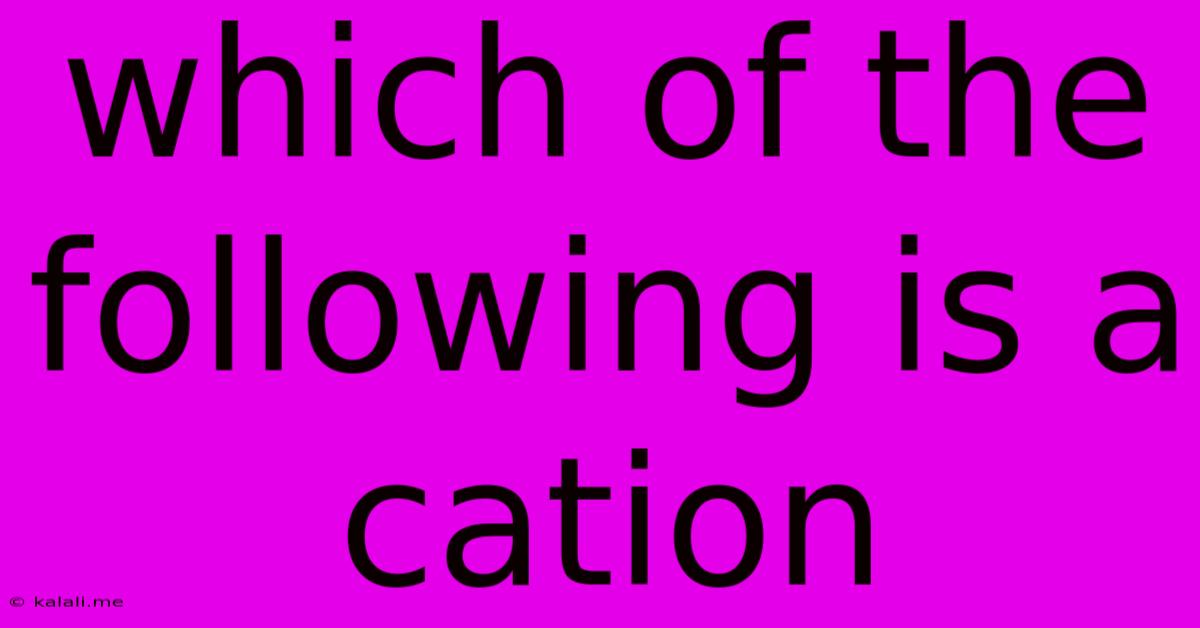Which Of The Following Is A Cation
Kalali
Jun 12, 2025 · 3 min read

Table of Contents
Which of the Following is a Cation? Understanding Ions and Their Charges
This article will delve into the world of ions, specifically addressing the question: which of the following is a cation? We'll define cations, explain how to identify them, and explore examples to solidify your understanding. Understanding cations is crucial for grasping fundamental chemistry concepts.
A cation is a positively charged ion. This means it has lost one or more electrons, resulting in a net positive charge. This contrasts with anions, which are negatively charged ions due to gaining electrons. The charge of an ion is crucial in determining its chemical behavior and interactions with other ions and molecules.
How to Identify a Cation
Identifying a cation requires understanding the basic principles of atomic structure and electron configuration. Here's a breakdown of how to determine if a species is a cation:
-
Look at the charge: The most straightforward way is to check the superscript charge. A positive superscript (e.g., +1, +2, +3) indicates a cation.
-
Consider the element's position in the periodic table: Metals generally lose electrons to form cations. Their position on the periodic table often indicates their common ionic charge. For instance, alkali metals (Group 1) typically form +1 cations, while alkaline earth metals (Group 2) typically form +2 cations.
-
Analyze the electron configuration: A neutral atom has an equal number of protons and electrons. If an atom loses electrons, it becomes positively charged, forming a cation. The number of electrons lost determines the magnitude of the positive charge.
Examples of Cations
Let's illustrate with some examples:
-
Na⁺ (Sodium ion): Sodium (Na) readily loses one electron to achieve a stable electron configuration, forming a +1 cation, Na⁺.
-
Ca²⁺ (Calcium ion): Calcium (Ca) loses two electrons to form a +2 cation, Ca²⁺.
-
Fe³⁺ (Iron(III) ion): Iron (Fe) can lose three electrons to form a +3 cation, Fe³⁺. Note that iron can also form a +2 cation (Fe²⁺).
-
Al³⁺ (Aluminum ion): Aluminum (Al) loses three electrons to become a +3 cation, Al³⁺.
Differentiating Cations from Anions
It's important to distinguish between cations and anions. Remember:
- Cations: Positively charged ions (lost electrons). Usually metals.
- Anions: Negatively charged ions (gained electrons). Usually non-metals.
The Importance of Cations in Chemistry
Cations play vital roles in various chemical processes and biological systems:
-
Ionic bonding: Cations form ionic bonds with anions, creating ionic compounds like sodium chloride (NaCl).
-
Electrolyte balance: Cations like sodium (Na⁺), potassium (K⁺), and calcium (Ca²⁺) are essential electrolytes in biological systems, regulating fluid balance and nerve impulse transmission.
-
Catalysis: Certain metal cations act as catalysts in chemical reactions.
-
Mineral composition: Many minerals are composed of various cations and anions.
In conclusion, identifying a cation involves understanding its positive charge, derived from the loss of electrons. By examining the charge, the element's position on the periodic table, or its electron configuration, you can confidently determine whether a species is a cation. Understanding cations is a fundamental aspect of chemistry with broad implications across various fields.
Latest Posts
Latest Posts
-
Annual Ordering Cost Is Inversely Related To Order Size
Jun 13, 2025
-
What Day Of The Week Is August 17th
Jun 13, 2025
-
Smallest Unit Of Meaning In A Language
Jun 13, 2025
-
Which Of The Following Are Measures Of Central Tendency
Jun 13, 2025
-
What Is The Lcm Of 2 4 5
Jun 13, 2025
Related Post
Thank you for visiting our website which covers about Which Of The Following Is A Cation . We hope the information provided has been useful to you. Feel free to contact us if you have any questions or need further assistance. See you next time and don't miss to bookmark.